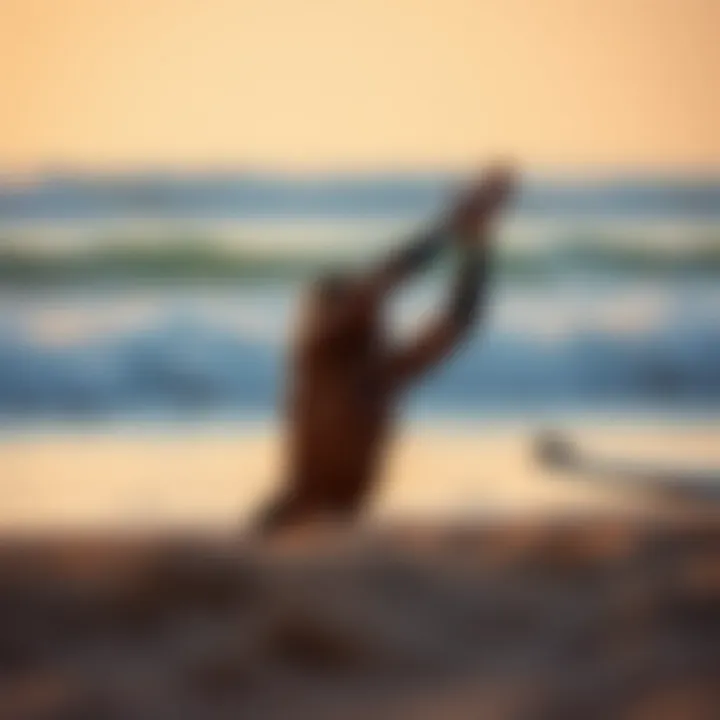Effective Strategies to Prevent Calf Cramps in Athletes


Intro
Calf cramps can be a real pain—both literally and figuratively. Many surfers, whether seasoned wave-riders or newcomers, have felt the sudden tightness that comes from vigorous paddling, awkward positions on the board, or even spinning out in a wave. Understanding the link between these cramps and muscle performance is key to enjoying those long days on the water without the agony of tight calves.
In this article, we’ll break down the intricate mechanisms that cause calf cramps, particularly for surfers engaged in physically demanding activities. We'll dive into practical strategies that don't just relieve these ailments, but also help prevent them altogether. From recognizing the importance of proper hydration to optimizing your nutrition, stretching, and recovery techniques—every detail matters in keeping your muscles happy and ready for action.
This guide will offer you a roadmap to maintaining muscle health so you can focus on the ride, not on the discomfort.
Gear and Equipment
When it comes to preventing calf cramps, having the right gear is essential. The equipment you choose can affect your overall performance and how your muscles respond during those crucial surfing sessions.
Latest Surfboard Technologies
Modern surfboards come with significant advancements aimed at enhancing performance while minimizing muscle strain. By adopting boards that feature lighter materials and superior hydrodynamics, you can reduce fatigue and keep your legs fresh. Consider exploring options like epoxy or foam-core boards that boast flexible characteristics while being sturdy enough to endure rough waves.
Essential Accessories for Every Surfer
Don’t overlook the little things—accessories can make a world of difference. Some essentials include:
- Wetsuits that provide enough insulation without restricting movement—an essential for those chilly morning surf sessions.
- Leg ropes that fit snugly, ensuring you remain connected to your board even in the most turbulent waters.
- Sunscreen & protective gear to guard against harmful UV rays. Sunburn can lead to dehydration and muscle cramps.
These accessories not only enhance your experience but also play a role in reducing the strain your calves endure while surfing.
The Role of Hydration
Hydration cannot be overstated. Proper electrolyte levels are crucial for muscle function and preventing cramps. Dehydration can lead to a reduction in the fluid surrounding muscles and joints, increasing cramping risk and lowering performance.
Be vigilant—sip on water or electrolyte drinks before, during, and after your surf sessions. The balance of sodium, potassium, and magnesium in your body continues to support muscle contraction and relaxation, potentially reducing those pesky cramps.
Nutrition Matters
Eating right also aids in cramp prevention. Here are some key dietary pointers:
- Complex Carbohydrates: Fuel up on pasta or quinoa to stock your energy reserves. Your muscles need fuel for exertion.
- Lean Proteins: Chicken or fish can aid muscle recovery post-surf. These proteins help in repairing any breakdown caused by intense activity.
- Fruits & Vegetables: Bananas, leafy greens, and avocados are loaded with nutrients essential to muscle health.
A well-rounded diet makes for strong muscles and can keep your legs ready for wave-riding.
Stretching Techniques
Incorporating stretching routines before and after surfing is a game-changer. Dynamic stretches before hitting the waves improve blood flow to muscles, while static stretches post-surf enhance flexibility and recovery. Here’s a simple stretch routine to consider:
- Calf Raises: Stand on the edge of a step and slowly lift and lower your body.
- Wall Push-ups: Stretch your calf by pushing against a wall while keeping your heels down.
Each little effort adds up to help maintain calf strength and reduce the risk of cramps.
Recovery Practices
Lastly, don't underestimate the power of recovery. After a hard day’s surf, consider practices such as:
- Foam Rolling: Relaxes and lengthens the calf muscles, reducing tension.
- Gentle Yoga: Incorporating a few yoga poses can boost flexibility and improve blood flow.
Taking care of your body off the board is just as essential as the time spent riding the waves. Your muscles deserve the chance to recover and repair.
As you navigate the exhilarating world of surfing, remember the fine balance between pushing your limits and nurturing your body. By understanding the causes of calf cramps and incorporating the recommended strategies, you'll set yourself up for success on the water and, ultimately, for those unforgettable rides.
Understanding Calf Cramps
Calf cramps are more than just an unexpected annoyance; they can affect performance and enjoyment, especially in demanding environments like surfing. Recognizing and understanding how they occur lays the groundwork for effective prevention strategies. Athletes and outdoor enthusiasts alike are well aware of the discomfort these muscle spasms can cause, but many might not delve into the specifics that lead to their occurrence. By grasping the science behind these cramps, surfers can take proactive steps to stave them off and enjoy longer days on the waves.


Definition of Calf Cramps
Calf cramps, often described as sudden, involuntary muscle contractions, typically involve the gastrocnemius and soleus muscles of the lower leg. It's like a jolt that catches you off guard, causing a tightening sensation that can range from mild discomfort to severe pain. Most often, they happen during or after intense activity, particularly when the muscle is under stress. While they can strike anyone, athletes tend to face a higher frequency due to factors unique to their exertions. Understanding what exactly calf cramps are is the first step in learning to prevent them.
Physiology of Muscle Contraction
For those interested in the biomechanics of the body, the process of muscle contraction is fascinating. When you move, signals from your nervous system prompt the muscles in your calves to contract. This complex interaction relies heavily on electrolytes—potassium and sodium, for example—that help transmit nerve impulses to your muscle fibers. If there's a disruption in this balance, or if the muscle is overworked, the result is often a cramp. Consider it a miscommunication where the muscles get excessively excited and lock up rather than relaxing as they should.
Common Triggers
Several factors can spark calf cramps, each requiring awareness and a tailored approach to mitigate their impact. Here are some common culprits:
- Dehydration: Losing fluids can alter the body's electrolyte balance, significantly increasing the likelihood of cramps.
- Electrolyte Imbalance: As previously mentioned, when there’s insufficient potassium or magnesium, muscles may cramp up.
- Overexertion: Pushing your body too hard, especially without proper preparation, can send your calves into spasm.
- Poor Stretching Practices: Failing to properly stretch before activities can leave the muscles tight and susceptible to cramping.
"Often, the simplest changes yield the best outcomes when it comes to preventing muscle cramps."
By understanding calf cramps' definition, physiology, and common triggers, surfers can develop a more effective approach to keeping their legs in prime condition for riding waves. Awareness is the first step; the next is action.
Common Sources of Cramps during Surfing
Calf cramps can surfacing at unexpected moments, especially during the rigorous activity of surfing. Understanding the sources that trigger these cramps is paramount for surfers seeking to enhance their performance and enjoyment in the water. The process of catching waves can subject the body to various stresses, which, if not managed, can lead to muscle spasms. Knowing your enemy is half the battle, so let’s take a closer look at three primary culprits: dehydration, electrolyte imbalance, and overexertion.
Dehydration
Dehydration often creeps in unnoticed, much like a hidden rip current. Surfers, energized by the thrill of riding waves, might focus more on their surfboards than on their hydration levels. When the body loses more fluids than it takes in, muscle function can falter. Dehydrated muscles are like a car running on empty—inefficient and prone to breakdown.
- Why Hydration Matters: Proper hydration is crucial for maintaining blood volume, muscle elasticity, and overall physical performance. Water also aids in nutrient transport, ensuring that your muscles receive what they need to function optimally.
- Signs of Dehydration: Watch for symptoms such as dizziness, excessive thirst, dry mouth, or dark urine. Ignoring these signs can lead to cramps, cutting your session short on a day you could have thrived.
Electrolyte Imbalance
Electrolytes, like sodium, potassium, and magnesium, play a significant role in muscle function. When these minerals are out of whack, it can spell trouble for surfers. You might find yourself cramping unexpectedly, which is about as fun as stepping on a nail.
- The Role of Electrolytes: These charged particles help send signals in the body, facilitating muscle contractions and nerve impulses. An imbalance often results from excessive sweating, which depletes the body of these vital minerals.
- Preventive Tips: Consuming sports drinks or snacks enriched with electrolytes can help restore balance. Think of packing some dried fruit or a handful of nuts to munch on during breaks—a wise move to keep cramps at bay.
Overexertion
Overexertion can be your downfall, especially if you’re trying to push past your limits just to catch that perfect wave. While challenging oneself is part of the sport, too much exertion without proper preparation can lead to strains and cramps. Muscle fatigue takes the fun right out of surfing!
- Recognizing Your Limits: Knowing when to paddle harder and when to take a breather is critical. Ignoring your body’s signals can result in cramps that knock you out for the day.
- Listening to Your Body: Be attentive to how your muscles feel. If they are fatigued or sore, take a moment to recuperate. Incorporate regular breaks to hydrate and refuel.
"An ounce of prevention is worth a pound of cure."
By understanding these common sources of cramps, surfers can take proactive steps to keep their muscles functioning smoothly and efficiently, allowing for longer, more enjoyable surf sessions. Whether it's hydrating adequately, balancing electrolytes, or recognizing the signs of overexertion, your body will take care of you when you take care of it.
Importance of Hydration
Hydration is a cornerstone of athletic performance, particularly for surfers. The act of surfing demands a multitude of physical feats, many of which can tax the muscles in intense ways. Staying well-hydrated isn't just a recommendation; it stands as a necessary practice to aid muscle function and overall endurance. Without sufficient water intake, not only can performance plummet, but the risk of cramps rises significantly.
Cramps, by definition, are involuntary muscle contractions that can lead to pain and discomfort. When muscles lack water, they can become unstable, increasing their likelihood of cramping. This is particularly crucial for surfers who are often engaged in activities that stress the calf muscles during paddling and riding. The importance of maintaining hydration levels cannot be overstated; it can mean the difference between riding a wave and being sidelined by an unwanted cramp.
"Hydration is key. If you're not drinking enough, your muscles will remind you, often painfully."
Several benefits stem from proper hydration:
- Muscle Function: Water aids in nutrient transport, which is essential for muscle contraction and relaxation.
- Temperature Regulation: Hydration helps regulate body temperature, critical for prolonged performances in warm weather.
- Performance Optimization: Well-hydrated muscles perform better and recover faster, sharpening one’s edge on the waves.
Surfers, like other athletes, need to be aware of their hydration needs and how they fluctuate based on weather and exertion levels. This understanding is fundamental to enhancing muscle performance and minimizing the risk of cramps, thereby elevating one’s entire surfing experience.
Nutrition's Role in Preventing Cramps


Nutrition plays a vital role in the prevention of calf cramps, especially for surfers and athletes who push their bodies to the limit. What goes into the body can have a profound impact not only on overall health but also on muscle function and performance. A well-balanced diet provides essential nutrients that support muscle contraction and relaxation, facilitating optimal performance on the waves. When your fuel is right, you’re much less likely to experience those pesky cramps that can ruin a good surf session.
Key Nutrients for Muscle Health
Several key nutrients contribute to muscle health and act as the backbone for preventing cramps. Here’s a closer look:
- Electrolytes: Sodium, potassium, calcium, and magnesium are crucial for muscle contraction and relaxation. These minerals help maintain fluid balance within cells, ensuring muscles are hydrated and functioning well. Low levels can lead to cramps.
- Protein: Vital for muscle repair and growth. Insufficient protein intake can weaken muscles over time, making them more prone to fatigue and cramping during intense activities.
- Carbohydrates: The body’s main source of energy, especially during high-intensity exercise. Low carbohydrate levels can lead to a decline in muscle performance, which might trigger cramps.
- Vitamins: B vitamins, particularly B6 and B12, support energy metabolism and neuromuscular function, which are important for muscle contraction.
Maintaining a balance of these nutrients in your diet can significantly decrease the likelihood of cramping, giving you one less thing to worry about when paddling out to catch those perfect waves.
Balanced Diet for Surfers
Surfers need to ensure their diets are not just focused on calories, but on quality nutrition to prepare their bodies for the demands of the ocean. A balanced diet should incorporate:
- Fruits and Vegetables: A colorful variety is key, as they provide essential vitamins, antioxidants, and minerals that combat oxidative stress and inflammation caused by intense physical activities.
- Whole Grains: Foods like brown rice, quinoa, and oats supply necessary carbohydrates and fiber, fueling your body for sustained energy.
- Lean Proteins: Chicken, fish, tofu, and legumes are excellent choices for obtaining proteins without excess fats, vital for muscle repair.
- Healthy Fats: Sources like avocados, nuts, and olive oil help in inflammation reduction and are essential for overall health.
“You are what you eat, so don’t be fast, cheap, easy, or fake.”
Surfers should strive to make meals that are both nutritious and enjoyable. Meal prepping or packing healthy snacks for the beach can help in maintaining energy levels and preventing cramping.
Making these adjustments in your diet isn’t just about avoiding cramps; it’s also about enhancing performance and recovery, ensuring that you’re in top shape for another day riding the waves.
The Significance of Stretching
Stretching plays a pivotal role in preventing calf cramps, especially for individuals engaging in vigorous activities like surfing. It’s not merely about flexibility; it goes deeper into promoting circulation, reducing the risk of injury, and enhancing overall muscle performance. Calves are often put through the wringer during athletic pursuits, and incorporating regular stretching can be a game changer for muscle resilience and endurance.
When the muscles are stretched properly, they adapt better to the demands placed on them. These adaptations help prevent the sudden contractions that characterize cramps. Additionally, stretching sends essential blood flow to the muscles, which in turn nourishes them with needed oxygen and nutrients. Without adequate stretching, muscles can tighten, making them more susceptible to spams. As the saying goes, "You don't want your engine to overheat before it’s time!" Keeping calves limber sets the stage for better performance on waves and beyond.
Effective Stretching Techniques
To maximize the benefits of stretching, there are specific techniques that can be implemented. Here are several methods that surfers can incorporate into their routine:
- Dynamic Stretching: Before hitting the waves, engaging in dynamic stretches can prepare your muscles. Simple leg swings or calf raises get the blood pumping.
- Static Stretching: After surfing, static stretches help cool down. Standing on one leg while pulling the other foot to your buttocks can really help.
- Calf Raises: Standing on the edge of a step, lowering your heels and then lifting back up can work wonders.
It's essential to hold each stretch for about 15 to 30 seconds. Avoid bouncing, which can cause strains. Focus on breathing deeply through each stretch. Remember, consistency is key; making these stretches a regular part of your routine can yield significant rewards.
When to Stretch
Timing is crucial when it comes to stretching. Knowing when to stretch can help gauge the effectiveness of your routine:
- Before Workouts: Engaging in a brief warm-up followed by dynamic stretches prepares the muscles for action. This can prevent strain when paddling or maneuvering on the board.
- After Workouts: Post-activity stretches, such as calf stretches, can relieve tension built up during intense sessions. This time is ideal for static stretching as your muscles are warm and can accommodate it better.
- During Downtime: Stretching doesn’t have to be limited to workout times. Even during long breaks at the beach, a few stretches can keep muscles from tightening up, allowing for a smoother ride when you're back in the water.
Implementing an effective stretching routine tailored to personal needs and schedules can go a long way in preventing calf cramps and ensuring smooth sailing on the surfboard. Investing this time is well worth the effort, turning you into a more resilient and agile athlete.
Incorporating Warm-Up Routines
When it comes to combating calf cramps, incorporating a well-structured warm-up routine can be a game changer for surfers. Warming up isn’t merely a prelude to working out; it’s an essential step that primes the body for physical exertion. A good warm-up increases blood flow to the muscles, enhances flexibility, and prepares the nervous system for action. For surfers, who often push their bodies to the limit riding the waves, the importance of a warm-up cannot be overstated.
The warm-up routine serves several purposes. First, it raises the muscle temperature, making them more pliable and able to withstand the demands of intense activity. Cold muscles are like untested rubber bands — they can snap under pressure. Additionally, a warm-up can mentally prepare an individual for the coming physical challenges, creating a state of focus and readiness.
Purpose of a Warm-Up
The benefits of warm-ups extend beyond just reducing the risk of cramps. Here’s how:
- Increases Blood Flow: A gradual increase in heart rate boosts circulation, sending more oxygen to the muscles. This process not only improves performance but aids recovery as well.
- Enhances Range of Motion: Effective warm-up routines engage various muscle groups, including the calf muscles. This active stretching improves flexibility, which is crucial for dynamic movements on a surfboard.
- Reduces Injury Risks: By adequately preparing muscles and joints, warm-ups lower the risk of strains, pulls, and cramps — allowing surfers to ride the waves without fear.
It’s clear that a warm-up goes beyond mere formality; it is a well-founded and crucial habit for anyone engaging in strenuous activities, especially surfers who demand a lot from their leg muscles.
Warm-Up Exercises for Calves


Implementing specific warm-up exercises targeting the calf muscles can make a noticeable difference. Below are several effective methods:
- Calf Raises: Stand with your feet together, then slowly raise your heels off the ground, standing on your toes. Hold for a few seconds and lower back down. Repeat this for 10 to 15 reps. This exercise strengthens the calves and prepares them for action.
- Dynamic Calf Stretch: While standing upright, take a step back with one foot, keeping the heel grounded. Push your hips forward to feel a gentle stretch in the calf of your back leg. Hold for 15-30 seconds and switch sides.
- Ankle Rolls: Standing or seated, lift one foot off the ground and rotate your ankle in circles. Do this in both clockwise and counterclockwise directions. This exercise helps increase the range of motion in your ankles, critical for maintaining balance on a surfboard.
- Lunges: Move forward into a lunge position, ensuring your front knee does not go past your toes. Alternate legs to target both calves effectively. Lunges not only warm up the calves, but also engage the entire lower body.
Incorporating these exercises into your warm-up routine can enhance muscle health and reduce the risk of cramps. Get in the habit of warming up before you paddle out. It’s a small investment of time that can significantly impact your surf sessions.
Recovery Techniques
When it comes to keeping calf cramps at bay, the significance of recovery techniques cannot be stressed enough. After intense physical activity, like catching a towering wave or pushing through the surf, your muscles need time to recuperate. Recovery has a direct impact on muscle health and, subsequently, can prevent the annoying muscle cramps that many surfers face. It’s like letting your car cool down after a long drive; if you skip that step, you risk serious damage. The right recovery practices allow your body to heal, maintain flexibility, and ultimately enhance performance.
Post-Exercise Cool Down
One of the first steps in an effective recovery routine is the post-exercise cool down. It’s similar to gently easing off the accelerator after a fast ride—suddenly stopping can cause more harm than good. A proper cool down helps to gradually lower your heart rate and brings blood flow back to normal levels, which is crucial after an adrenaline-charged surfing session.
- Benefits: Cooling down benefits more than just your heart rate. By allowing your muscles to gradually transition back to resting state, you can help reduce muscle stiffness and soreness post-exercise. This is particularly important for surfers who rely heavily on their calf muscles to keep balance and stability.
- How to do it: Start with at least five to ten minutes of light activity, like walking or gentle cycling, to help purge lactic acid from the muscles. Follow that with a stretch—it signals your body that it's time for recovery. Pay special attention to your calves by incorporating stretches that extend the calf muscles.
Foam Rolling for Muscle Relief
Once you've cooled down, foam rolling can be your secret weapon in combatting calf cramps. This technique is not complicated; it acts like a personal masseuse that fits right in your gym bag. Foam rolling helps release tension in muscles and fascia, the connective tissue that surrounds muscles. It can feel a bit like giving your muscles an intense but soothing hug.
- Why it's effective: Foam rolling increases blood circulation and can also loosen knots or tight spots in the muscle tissues. These knots are buggers that can lead to cramps during or after activity. Spending a few minutes rolling out your calves after a surf session can make a world of difference in preventing cramps.
- How to roll: Position the foam roller under your calf and slowly shift your body weight onto it. Roll from your Achilles tendon to just below your knee, pausing at any tender spots for 15-30 seconds. Make sure to breathe deeply; it’s about relaxing both your body and mind.
By integrating post-exercise cool downs alongside foam rolling into your recovery routine, you’re setting yourself up for success. Not only are these techniques excellent for easing muscle tension, but they also pave the way for smoother sailing, or in your case, more successful surfing sessions.
Seeking Professional Help
Addressing calf cramps is important not only for comfort but also for maintaining overall muscular health. While many surfers and outdoor enthusiasts often seek immediate home remedies or suggestions from fellow athletes, there are certain scenarios where professional help can make all the difference. Consulting specialists provides deeper insights into persistent issues and can lead to tailored solutions that align with a person’s unique physical makeup and the rigors of their activities.
Why Consider Professional Help?
When dealing with recurrent cramps, it’s wise to consult a healthcare professional, particularly if the discomfort starts interfering with performance or daily life. A specialist can provide clarity on underlying issues that might not be apparent. Several aspects warrant this consideration:
- Expertise and Diagnosis: A trained physical therapist or sports medicine doctor can accurately assess muscle imbalances or deficiencies that might be causing cramps. Sometimes, what appears to be a simple cramp may have roots in biomechanical issues or nutritional deficiencies.
- Avoiding Injury: Ignoring persistent muscle cramps could lead to overuse injuries. Getting a professional evaluation ensures that the root cause is addressed, preventing further complications down the line.
- Personalized Treatment Plans: Each individual’s body is different. A professional can devise a specific rehabilitation or prevention regimen that considers a person's surfing habits and physical needs, maximizing effectiveness.
"An ounce of prevention is worth a pound of cure." - Benjamin Franklin
Seeking help early can prevent more significant issues later.
When to Consult a Specialist
Identifying the right moments to seek help can be fundamental. Here are key indicators:
- Persistent or Severe Cramps: If cramps become a frequent and unbearable occurrence—happening multiple times during sessions or affecting daily movements—this might signal a need for professional insight.
- Changes in Muscle Function: Unexplained weakness in the calves, swelling, or a noticeable reduction in performance can warrant a visit to a specialist. These signs often indicate deeper concerns that need addressing rather than just symptom relief.
- Symptom Fluctuations: If the symptoms change in intensity or character, this inconsistency suggests that something more than hydration or stretching could be at play.
- Previous Injuries: Individuals with a history of calf or leg injuries should definitely seek professional advice, as cramps can be indicative of underlying issues stemming from past trauma.
Physical Therapies for Cramps
Once a specialist is consulted and a diagnosis is made, various physical therapy techniques may be recommended:
- Manual Therapy: Techniques such as massage or myofascial release can help alleviate tightness in the muscle fibers, promoting blood flow and recovery.
- Strengthening Exercises: Building calf strength through specific targeted exercises can remarkably improve muscle resilience and function—this often involves eccentric loading, which is great for muscle fortitude.
- Electrical Stimulation: In some cases, therapists may use electrical stimulation to enhance muscle activation and thus decrease cramp occurrences.
- Education on Posture and Movement: An often-overlooked aspect of preventing cramps is ensuring correct body mechanics. Specialists can offer advice on proper posture while surfing or engaging in other activities to minimize stress on the muscles.
In summary, understanding when to consult a specialist and the potential therapies available contributes significantly to preventing calf cramps and ensuring peak athletic performance.
The End
In wrapping up, it's essential to acknowledge the crux of preventing calf cramps as an athlete and, in particular, a surfer. Calf cramps can strike when you least expect them, throwing your rhythm and enjoyment right off balance. Hence, dedicating attention to this topic isn’t merely beneficial; it's absolutely crucial for optimal performance.
Summarizing Key Points
The discussion throughout this article has encapsulated several fundamental elements in the fight against calf cramps.
- Understanding Muscle Function: Gaining insight into how calf cramps manifest is the first step in prevention. By recognizing physiological triggers, athletes can make informed decisions.
- Hydration is Key: Staying well-hydrated ensures muscles function properly. As we’ve outlined, water, electrolytes, and nutrition play a vital role in maintaining that balance.
- Stretching and Warm-Up Routines: Neglecting these practices can lead to increased cramp occurrences. Integrating well-planned stretching techniques can significantly reduce strain.
- Recovery Practices: Learning effective recovery strategies such as foam rolling and cooldown routines ensures that your muscles have a chance to recuperate post-exercise.
- Professional Help: Recognizing when to seek advice is also an element that can’t be overlooked. A physical therapist can provide insights tailored to individual needs.
All of these components coalesce into a comprehensive approach, aiding surfers and athletes to keep calf cramps at bay, ensuring they can pursue their passions with greater ease and less discomfort.
Encouraging Preventative Measures
Being proactive is the name of the game here. As a surfer traversing the waves, adopting a lifestyle that emphasizes calf health can lead to substantial benefits. Here are some tangible steps you can take:
- Prioritize Hydration: Carry a water bottle while surfing. Monitoring your water intake ensures that dehydration doesn’t catch you off guard. Aim for at least 2 liters a day, especially during warm weather.
- Educate Yourself on Nutrition: Make it your mission to include nutrient-rich foods in your meals. Foods high in magnesium, potassium, and calcium like bananas, spinach, and yogurt are particularly beneficial.
- Incorporate Stretching into Your Routine: Schedule time for calf stretches a couple of times a week. Consistency is key. Not only will this enhance flexibility, but it will also prepare your muscles for the rigorous activity.
- Warm-Up Before Hitting the Waves: Establish a warm-up routine that engages your calves. Even a few minutes dedicated to light exercises can make a big difference.
- Listen to Your Body: Pay attention to the signals your body sends. If something feels off, it might be time to consult a medical professional for tailored advice.
By embracing these preventative strategies, you bolster your muscle health and stay in the game longer, enjoying every swell and maintaining your performance at peak levels. Remember, an ounce of prevention is worth a pound of cure!







